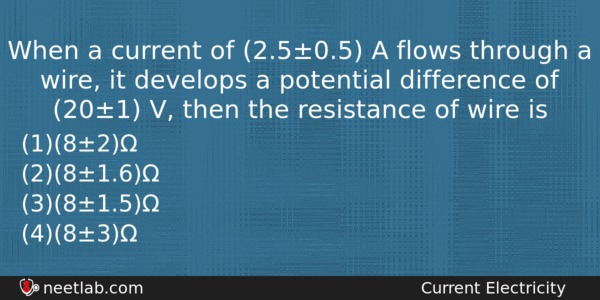| ⇦ | 
| ⇨ |
When a current of (2.5±0.5) A flows through a wire, it develops a potential difference of (20±1) V, then the resistance of wire is
Options
(a) (8±2)Ω
(b) (8±1.6)Ω
(c) (8±1.5)Ω
(d) (8±3)Ω
Correct Answer:
(8±2)Ω
Explanation:
No explanation available. Be the first to write the explanation for this question by commenting below.
Related Questions: - If a star converts all helium in its core to oxygen, then energy released per oxygen
- The angular velocity of a wheel increases from 100 rps to 300 rps in 10 seconds.
- A car of mass m is moving on a level circular track of radius R
- A spring when stretched by 2mm containing energy 4 J. If it is stretched
- Water flows through a pipe. The area of cross-section at one place A₁=10 cm²,
Topics: Current Electricity
(136)
Subject: Physics
(2479)
Important MCQs Based on Medical Entrance Examinations To Improve Your NEET Score
- If a star converts all helium in its core to oxygen, then energy released per oxygen
- The angular velocity of a wheel increases from 100 rps to 300 rps in 10 seconds.
- A car of mass m is moving on a level circular track of radius R
- A spring when stretched by 2mm containing energy 4 J. If it is stretched
- Water flows through a pipe. The area of cross-section at one place A₁=10 cm²,
Topics: Current Electricity (136)
Subject: Physics (2479)
Important MCQs Based on Medical Entrance Examinations To Improve Your NEET Score
18000+ students are using NEETLab to improve their score. What about you?
Solve Previous Year MCQs, Mock Tests, Topicwise Practice Tests, Identify Weak Topics, Formula Flash cards and much more is available in NEETLab Android App to improve your NEET score.
Share this page with your friends

R=V/I
R=20/2.5
R= 8 ohm
Now,
∆ R/R=∆ V/V+∆I/I
=1/20 +0.5/2.5
= 1/4
Therefore,
∆ R÷R=1÷4
∆ R=1÷4×R
∆R=1÷4×8
∆R=2
Therefore,
Resistance with error limits=R+ – ∆R
=(8+ – 2)ohm